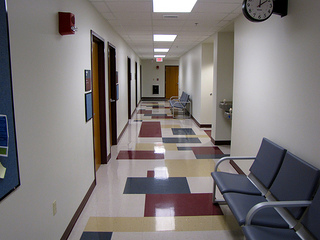Close your eyes. Now, visualize a college or university history department. Maybe the one you work in, or perhaps the one you studied in as an undergraduate. Or if you weren’t a history student, one you visited at some point in your life.
I bet I can tell you what it looks like, floating there in your mind. There is a hallway. Maybe a long hallway. With lots of posters and flyers tacked up. And a sign that says “Department of History.” You walk in and find a receptionist and a bunch of faculty mailboxes. Maybe a printer or a copier. And up and down the hall are doors, almost all of them closed, with cartoons, announcements, and other ephemera of faculty lives taped on those doors. A few of the doors are open, so you peek in and you see books. Lots of books. Some of th e offices are neat and tidy, others are pretty messy. Almost all of them are small.
e offices are neat and tidy, others are pretty messy. Almost all of them are small.
You might wonder what sorts of intellectual work takes place in those offices. Research? Writing? Collaboration with colleagues in other states or countries? Probably some grading too. Those offices can be interesting and inviting, or so messy that they are a little scary, but they tend to fit our notions of what a professor’s office looks like, even if the work taking place there often doesn’t. Too often what happens there is all about just trying to stay on top of email or campus committee work. And grading. Plenty of grading. Research does happen, but most of that is across an Ethernet or wireless connection these days.
History departments around the country are of a piece with this description because they’re artifacts of the way the professoriate in most universities has developed – the professor as semi-independent contractor, who has a campus office that is his/her base of operations for teaching and research. Those offices are places to meet with students and colleagues, but only rarely are the location of serious, sustained intellectual work. That part of our professional lives mostly takes place elsewhere, most often at home, but also in libraries, archives, in the field, or in a coffee shop with a good wireless connection.
So what? Why worry about our physical spaces when we have so many other issues on our plates? After all, we’ve muddled along with this physical model of history departments for more than a century. Why not just stay the course, or at least ask for a bigger office, preferably with a window?
I can think of several reasons why right now, today, historians need to be not only thinking critically about the kinds of spaces we’re in, but also advocating as loudly as possible for change in those spaces. At the top of my list are three prominent contenders: the growing importance of digital in the history (and humanities) curriculum; the now seemingly ubiquitous pressure to incorporate more online or hybrid course options into our curricula; and the growing importance of undergraduate research in college curricula more generally. If we don’t press hard for changes in the spaces we have – the typical history department you imagined – we’re going to have a difficult time making any headway in either of these two emerging areas of our endeavors, both with undergraduate and graduate students.
Over the next several days, while historians from across the country and around the world are assembled here in Washington, D.C., for the annual meeting of the American Historical Association, I’m going to explore our history spaces, and how we ought to begin thinking about changes in those spaces to help us prepare for the teaching, learning, and research environment we’ll find ourselves in in the coming decade.
I’ve previously taken up the issue of spaces and learning in this blog, and my series this week is certainly inspired, in part, by the thinking I did on this subject back in November 2012. But that thinking was about classrooms. This series is more about our departmental spaces — spaces that I believe will be more central to our success in years to come than we currently give them credit for.
This is such a great topic!
I started a new job in 2013 and for the first two weeks didn’t have an office (reorganization took a bit longer than anticipated). I wasn’t bothered by my lack of office as I spent most of my time trying to find my way around a huge campus and a new city.
What was most important for me in getting integrated into a new faculty was my access to a shared virtual space. In this case it was just a simple Blackboard site containing a repository of course documents, writing assignments, readings, lesson ideas etc. The Bb site also had a calendar of events, minutes from past meetings, documents and forms. Access to this information was really valuable and not only helped me prep new courses but also gave me a sense for faculty interests. I’m in a department with about 40 faculty spread out over 4 campuses. A virtual space, even one as basic as a shared Bb site, made me feel connected.